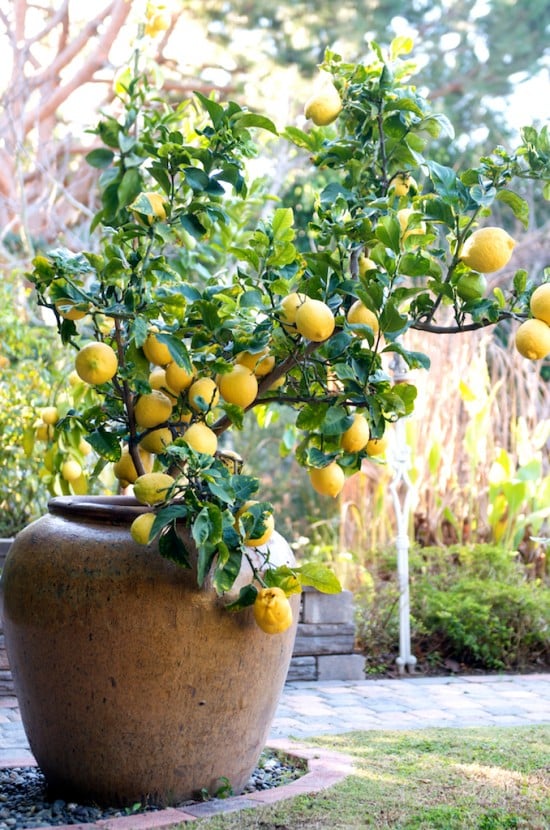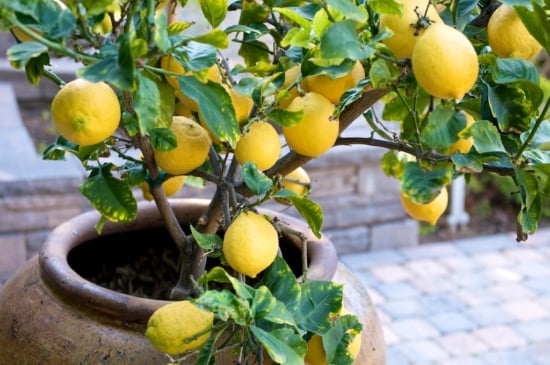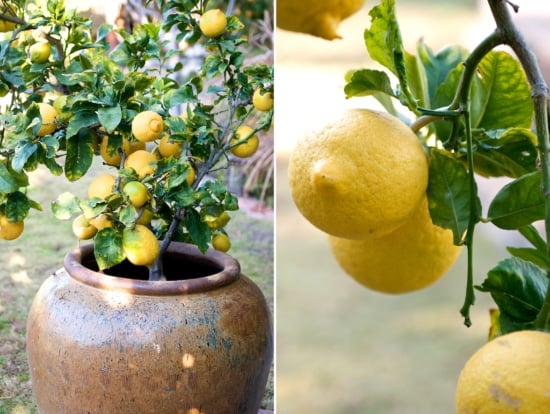How to Grow a Lemon tree in a Pot
Welcome to our tips on how to grow a lemon tree in a pot. These original photos are copyrighted to us and if you see these images stolen and used anywhere else on the web or in videos, please let us know. We appreciate it!

How to Grow Lemon Tree in Pot
After a visit to Sorrento Italy in April of 2000, we were immediately smitten with all the wonderful lemon trees adorning the Italian coastline. All throughout Amalfi and Sorrento we saw gorgeous scenes of Sorrento lemon trees in terra cotta pots adorning house fronts, store fronts and cobblestone alley ways.
We knew right there and then we wanted something equally picturesque in our backyard. So, we planted a lemon tree in a container and want to show you how to grow lemon tree in pot.
We really wanted to bring back a Sorrento lemon tree to the USA, but because we didn’t feel like smuggling anything into the country, we opted for the next best option possible – a Eureka lemon tree. This Eureka is studded with fruit and it’s extremely happy with its home in the urn shaped container. In winter, when the cool weather beckons the fruit to ripen, the lemon tree is an absolutely gorgeous scene to the garden.
This little lemon tree is our reminder of our trip to Italy and we’re happy to have it on our garden family.
Choose A Glazed Pot
Growing this lemon tree has a few challenges because the heat of the Summer season can quickly dry out the pot. If the tree is older and root bound, they’ll definitely dry out quicker, especially in the rustic looking terra cotta pots. They frequently will sweat out water which a glazed pot will retain. We’ve since transplanted it into the glazed pot seen in these photos and it is much happier. It takes consistent watering during hot Summer weeks to make sure that the tree stays hydrated and happy. Unfortunately there were a few occasions when we forgot to water our little lemon and the fruits became soft and dehydrated. The glazed pot helps but it can’t amend for neglect.
Watering Your Lemon Tree
To keep it consistently watered, we added a drip irrigation line to the pot. Now the lemon tree is in full fruiting cycle again because it’s getting the consistent water it needs to stay healthy. Another added step we’ve found to help keep in the hydration is to mulch the top of the pot. We use about 2″ of leaves which were left over from trimming our hedges. If you don’t have a way to put an automatic drip on the pot, then you have to be consistent in hand watering. What ever you do, make sure the lemon gets consistent water.
A word of warning on pot selection: if you ever think you may transplant out of the pot you are choosing, do not get a pot which tapers in at the rim like the one our Eureka lemon tree is in. It will be very difficult to take the plant out without damaging its roots. Luckily this pot is large enough to be our Eureka’s permanent home.
Feeding and Fertilizing
Make sure to feed your lemon tree with a good organic fertilizer. Think of all the baby lemons the tree needs to nurture, so make sure to give your tree great food and nutrients. Citrus need nutrients and since there is nowhere for the roots to go outside the pot, it is even more important in citrus planted in pots.
One key feeding tidbit we’ve found, citrus can’t absorb zinc and phosphate at the same time. We were getting yellowing in between the veins of the leaves, usually a sign of nutrient deficiency (commonly either zinc or manganese in our area). Most fertilizers didn’t seem to help until we found this knowledge from a university’s research. After checking labels and finding a fertilizer which didn’t have phosphate but did have zinc and manganese, the tree almost immediately starting looking better. They still do need some phosphorus (phosphorus is the element – phosphate is a salt containing phosphorus – you’ll see them both used in labeling), but we’ll make sure to vary the feedings at least 6 weeks apart.
Full Sun or Part Full-Sun?
We found that placing the lemon in full Southern California sun all day long, especially in Summer, is too much. Our citrus we have planted in the ground can handle the full day sun, but it was too much for this potted lemon tree. The heat is intense and stresses it out. So we moved it to a section of the garden that gets sun for about 2/3 of the day, then remains in shade. This combination worked best because the tree still was able to get great morning and afternoon sun until 2pm, but was able to avoid the intense late afternoon sun.
!! Check with Your Local Nursery. Can you even grow citrus in your area?
The best advice we can give you is to consult with your local nursery. Every growing region is different and growing zones can change rapidly even within 10 miles of each other. So head to your local nursery and check to see what variety of lemon tree grows well and ask for their advice on how you can best grow it for your area.
More Delicious Articles:
- Visit our latest citrus joy: Kishu Mandarin Tree!
- What is air frying? Our guide and source for air fryers
- Roasted broccoli salad
- One pot, stove top creamy kale mac and cheese recipe
This post was originally published in 2010 and republished in 2016 with updated information and tips. Have Fun when your grow lemon tree in pot!






